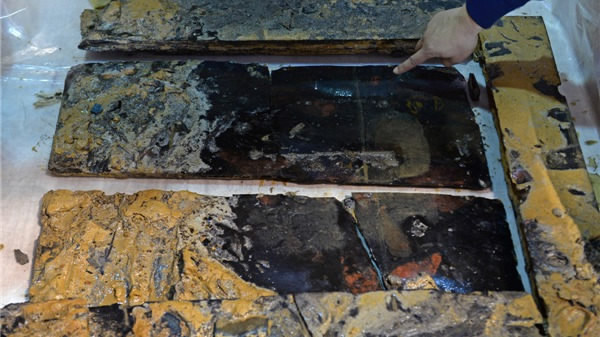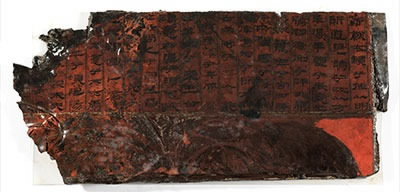
The relic is initially considered a lacquer screen after being unearthed from Marquis of Haihun's tombs in Nanchang, Jiangxi Province in east China. (Photo/Xinhua)

The text on the back of the dressing mirror found in Marquis of Haihun's tombs (Photo/CCTV.com)
During the excavation of the royal tombs of the Marquis of Haihun State of China's Western Han Dynasty (206 BC-8 AD), a relic with the earliest portrait of Chinese philosopher Confucius ever discovered has attracted lots of attention. Initially believed to be a lacquer screen, it has recently been re-identified as a dressing mirror by archaeologists.
Widely considered the best-preserved royal cemetery of the Western Han Dynasty, Marquis of Haihun's mausoleum contains eight tombs and a chariot burial site, covering an area of roughly 40,000 square meters. After five years of excavation and study, relics from the cemetery were exhibited at the Capital Museum in Beijing in spring last year.
Experts believe that the one buried in the main tomb was Liu He, who was demoted to be "Haihunhou" (Marquis of Haihun) after a dramatic 27-day stint as emperor. He died in his early 30s in Haihun, which is located in modern day Nanchang in east China's Jiangxi Province. His cemetery was discovered in 2011.
Widely considered the best-preserved royal cemetery of the Western Han Dynasty, Marquis of Haihun's mausoleum contains eight tombs and a chariot burial site, covering an area of roughly 40,000 square meters. After five years of excavation and study, relics from the cemetery were exhibited at the Capital Museum in Beijing in spring last year.
Experts believe that the one buried in the main tomb was Liu He, who was demoted to be "Haihunhou" (Marquis of Haihun) after a dramatic 27-day stint as emperor. He died in his early 30s in Haihun, which is located in modern day Nanchang in east China's Jiangxi Province. His cemetery was discovered in 2011.
New evidence supports Wang's opinion. According to CCTV reporters Wang Shuchang and Du Xichen, archaeologists have identified a written description on the relic, indicating that it was a dressing mirror.
The mirror is 70.3 centimeters high and 46.5 centimeters wide, comprising a mirror body, a mirror frame and a mirror cover. The rectangle mirror body is made of smooth bronze. The text on the back of the mirror contains more than two thousand Chinese characters, which give a detailed introduction of Confucius and his disciples.


















































